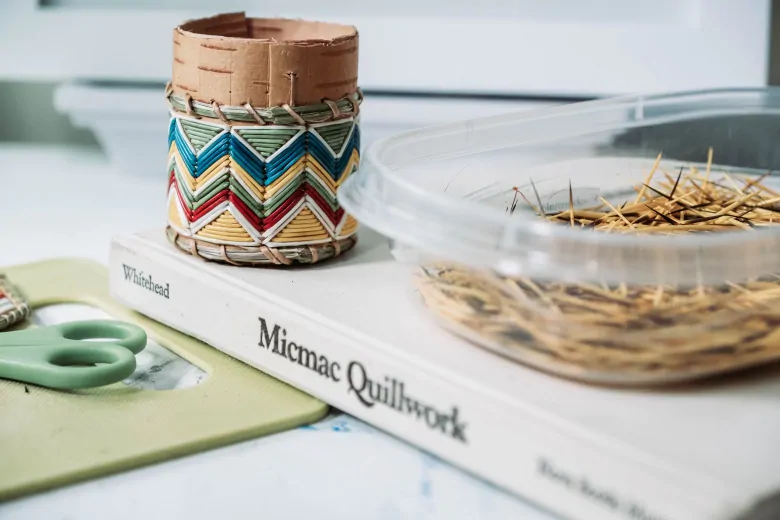P.E.I. quill artist scans roadsides for the remains that let her work

Melissa Peter-Paul drives from her home in the Abegweit First Nation in Prince Edward Island to gather the materials she needs for her art.
But it’s not paint or clay she comes to collect. It’s roadkill.
Peter-Paul is a quillwork artist. She uses porcupine quills to create intricate designs that can stand alone in a frame or adorn wood, leather and other materials.
Her medium is a prickly one and one not readily available to her.
She has to harvest the quills from dead porcupines she finds on the side of the road.
Porcupines are not native to Prince Edward Island. Peter-Paul scours the highways of Nova Scotia and New Brunswick to find carcasses to load into her cooler and take back to her home in Scotchfort, about 25 kilometres notheast of Charlottetown.
Once there, she painstakingly separates the porcupine fur with one hand and uses the other to pluck the quills. Tens of thousands of them.
Porcupine quilling is an art form unique to North America. The use of quills to add ornamentation to clothing, jewelry, medicine bags and boxes can be dated back to the sixth century.
Many quillers switched to beadwork when beads became readily available. It requires the same skills as quillwork, but it’s less gruelling.
Quillwork is nearly a lost art.
But people like Peter-Paul are keeping it alive. For her, it’s more than a job. Porcupine quilling is a calling.
“As soon as I picked up the quills, it was like this is what I was meant to do,” Peter-Paul said. “You wait all your life to find out what you want to be when you grow up. In that moment I was like ‘this is it!'”
Peter-Paul goes through about half a dozen porcupines a year for her art. One porcupine can yield around 30,000 quills.
The ancient indigenous art form involves softening and dying the quills and weaving them onto leather or birch bark for ornamentation.

Peter-Paul said quilling has been integral to her Mi’kmaq identity.
“The ancestors’ presence when I do quillwork is so strong and I really feed off of it.”
Her interest began in 2014, when she took a workshop from her cousin who was visiting from Nova Scotia.
At first, it began with triangles and other simple patterns. It evolved into more intricate designs inspired by an old book Peter-Paul read on Mi’kmaq quillwork.
The pictures in the book are black and white. Peter-Paul said the vistas of the Island inspired her to bring colour to the designs and make them her own.
“I saw lupines and I saw the red clay, and then I saw the ocean waves and the grass, and I used all those colours.”
Peter-Paul went on to complete a 20-week apprenticeship with her cousin and eventually to conduct her own workshops across the Maritimes.
Reviving family tradition
For Peter-Paul, quilling has revived a family tradition that was lost over generations.
Her great-great-grandmother was a quiller. Her works have been archived at the Nova Scotia Museum in Halifax. Without having a mentor in the province, Peter-Paul looks to the art of her ancestors for inspiration, often helped along by the soul-cleansing smoke produced by smudging, the practice of burning sacred medicines.
“When I’m stuck on something, I have to light up my smudge and I pray … so when I’m sitting there with those old quill pieces, it’s almost like I’m jumping into a time machine and I’m getting all of the answers.”
Her grandmother and mother were both basket makers. Peter-Paul said likes to incorporate sweet grass into her work, because her grandmother would harvest it by the river near her community for her baskets.
“It’s really important to me to still be using all of our traditional materials in that connection with my grandmother.”
Today, there are about half a dozen quillers on the Island.
Peter-Paul has exhibited her work with other artisans in the province. This past summer, she had her first solo exhibit in downtown Charlottetown and in November, she won the P.E.I. arts grant, the only Indigenous woman to receive the grant this year.
“I have people that still encourage me to keep this going because everybody else sees the importance of keeping quill work going.”

Peter-Paul is also a mother. Just as she has looked to the voices of her ancestors to guide and inspire her in her art, she now tries to bestow that wisdom on her two children.
“My oldest son is 12, so he’s harvesting porcupine with me. My children are all a part of my process and I make sure this is their normal. They see a porcupine on my step and they’re like, ‘Oh, hey, Mom’s working today.’ This is their normal.”
Peter Paul laughed as she spoke.
“So my boys will be quillers.”





